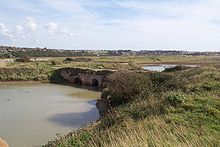| Revision as of 09:21, 10 November 2008 editSimon2239 (talk | contribs)191 edits Undid revision 250837067 by Bonadea (talk)← Previous edit | Revision as of 09:23, 10 November 2008 edit undoBonadea (talk | contribs)Edit filter helpers, Autopatrolled, Extended confirmed users, Page movers, New page reviewers, Pending changes reviewers, Rollbackers151,774 editsm Reverted edits by Simon2239 (talk) to last version by BonadeaNext edit → | ||
| Line 1: | Line 1: | ||
| {{Db-advert}} | |||
| {{infobox UK place | {{infobox UK place | ||
| |country = England | |country = England | ||
Revision as of 09:23, 10 November 2008
Human settlement in England| Tide Mills | |
|---|---|
| OS grid reference | TQ459002 |
| District | |
| Shire county | |
| Region | |
| Country | England |
| Sovereign state | United Kingdom |
| Police | Sussex |
| Fire | East Sussex |
| Ambulance | South East Coast |
| |


Tide Mills is a derelict village in East Sussex, England. It lies about 2 km southeast of Newhaven and 4 km northwest of Seaford and is near both Bishopstone and East Blatchington.
The old village
The village consisted of a large tide mill and numerous workers' cottages, housing about 100 workers. The tide mill at Bishopstone was erected in 1761 by the Duke of Newcastle, and was later owned and operated by William Catt (1770-1853) and his family.
The Sussex Archaeological Society started a long-term project in April 2006 to record the entire East Beach site: Mills, Railway Station, Nurses Home, Hospital, RNAS Station and the later holiday homes and the Marconi Radio station (1904). Apart from the dig, it will evolve into a huge collection of film, video, recollections and photographs logging the decline of the area.
The mill stopped in around 1900, the village was condemned as unfit for habitation in 1936 with the last residents forcibly removed in 1939. The area was in part cleared to give fields of fire and also used for street fighting training. The site was not used for target practice by Newhaven Fort Artillery, though this story is common locally.
The area accommodated vast numbers of Canadian troops during the Second World War.
There are the remains of a station on the Newhaven to Seaford line at grid reference TQ460003. It started life as either Bishopstone Station (the Victorian OS map of 1879 shows it as this together with a short branch line to the mills) or Tide Mills Halt, but became Bishopstone Beach Halt in 1939 before its closure in 1942. This is different from today's Bishopstone railway station at grid reference TV469998.
Mill complex

Old photographs and paintings, together with a poem show that the tide mill complex included a windmill.
Access
Access is either via Mill Drove, an insignificant single track road which runs south west from the Newhaven and Seaford roads at approximately the point where one changes into the other grid reference TQ463005 (very limited parking, and access is via a pedestrian railway crossing at Bishopstone Beach Halt); or along the beach to the east of Newhaven Harbour.
See also
References
- Bishopstone, the Largest Tide Mill in Sussex
- Newhaven Local & Maritime Museum - A Selection of Local Subjects
- The Sussex Archaeological Society Tide Mills archeology project
- Newhaven Local & Maritime Museum
- The train now standing at Bishopstone Beach
- Bishopstone Beach Halt station
- The Victorian OS map of 1879
- Source- plaques on the site for visitors
External links
- Friends of The Tidemills and Newhaven Eastside Conservation Group
- Corn. Bishopsten (sic), Sussex. Tide mills. Petition of merchants for sanction to build tide mills for grinding corn
- Outreach Helps to Turn the Tide
- Saline Lagoons The pound for the tide mill as a wildlife habitat
- Tidemills - a sustainable energy story